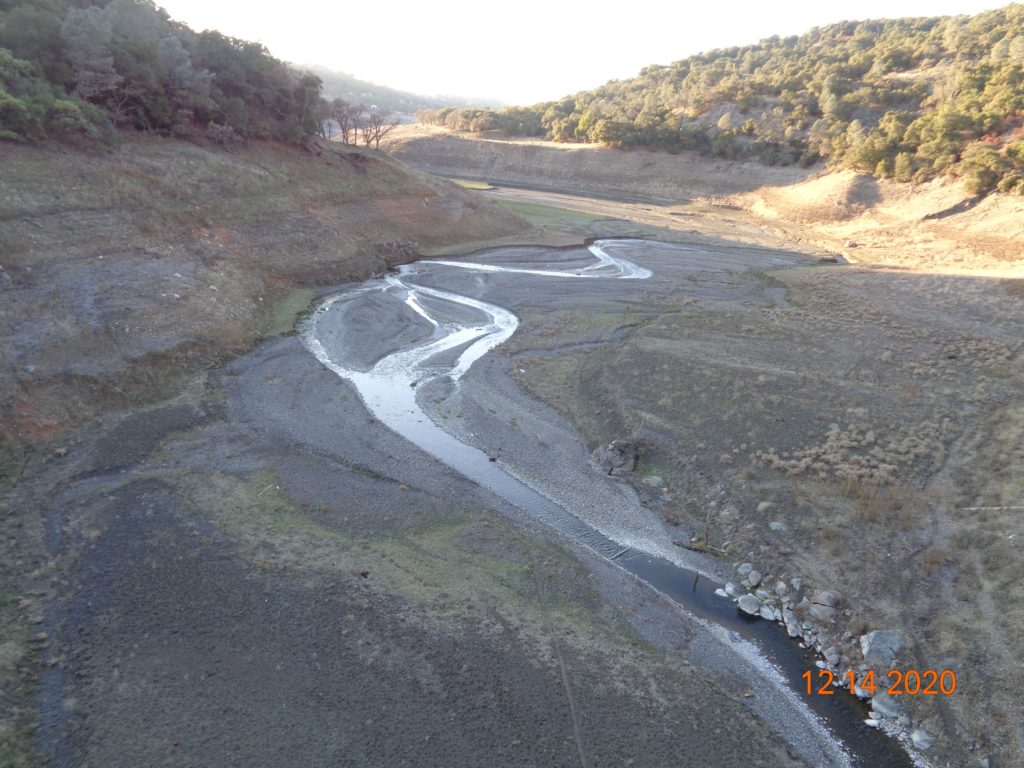It will take 10 years to complete the entire $576 million project

Photo courtesy Valley Water
Anderson Reservoir is at 3 percent capacity as the water district readies for seismic upgrades.
By Marty Cheek
After two and a half months of draining efforts, Anderson Reservoir is nearly empty at only 3 percent of water left — and will remain so for at least the next four years. The man-made lake had been 18 percent full Oct. 1.
In a Zoom press conference on Tuesday Dec. 15, Santa Clara Valley Water District officials announced that construction will begin most likely in spring on the $576 million, 10-year earthquake repair project to rebuild Anderson Dam and bring it up modern seismic safety requirements.
 The 40-foot earthen dam was built in 1950. Problems with that dam’s structure were identified 12 years ago, engineering studies indicating that a 6.6 magnitude earthquake on the Calaveras Fault under the reservoir or a 7.2 quake one mile away might cause the dam to fail. If that happened while the reservoir was full, a 35-foot wall of water would devastate downtown Morgan Hill in 14 minutes, and wipe through Gilroy less than an hour later. The water would reach San Jose in three hours at a depth of 8 feet, potentially drowning thousands of residents.
The 40-foot earthen dam was built in 1950. Problems with that dam’s structure were identified 12 years ago, engineering studies indicating that a 6.6 magnitude earthquake on the Calaveras Fault under the reservoir or a 7.2 quake one mile away might cause the dam to fail. If that happened while the reservoir was full, a 35-foot wall of water would devastate downtown Morgan Hill in 14 minutes, and wipe through Gilroy less than an hour later. The water would reach San Jose in three hours at a depth of 8 feet, potentially drowning thousands of residents.
Valley Water director John Varela noted the occurrence of two small earthquakes one mile east of Anderson Dam on the Calaveras Fault the day before the press conference, one 3.5 and the other 3.7 in magnitude. A routine check was made of the dam and no damage was found, he said.
“This is why the seismic retrofit of Anderson Dam is Valley Water’s top priority,” he said. “To protect the public and keep them safe in case of a major earthquake. The project will help us project our regional water supply and provide environmental benefits.”
Anderson Reservoir is by far the largest in Santa Clara County, capable of holding nearly 89,278-acres feet of water, more than the combined other nine dams operated by the district.
 Valley Water lowered the water levels in Anderson Reservoir in response to an order by the Federal Energy Regulatory Commission to reduce the risk to the public should Anderson Dam fail during a major earthquake. Valley Water released water at a rate of about 200-acre feet per day, or 65 million gallons a day. It may continue to release water from Anderson Reservoir once it begins capturing storm runoff from winter rains, maintaining the 3 percent level as it moves forward with work on projects designed to strengthen Anderson Dam.
Valley Water lowered the water levels in Anderson Reservoir in response to an order by the Federal Energy Regulatory Commission to reduce the risk to the public should Anderson Dam fail during a major earthquake. Valley Water released water at a rate of about 200-acre feet per day, or 65 million gallons a day. It may continue to release water from Anderson Reservoir once it begins capturing storm runoff from winter rains, maintaining the 3 percent level as it moves forward with work on projects designed to strengthen Anderson Dam.
The next step in the work at Anderson Dam is to build a 1,700-foot-long tunnel, up to 24-feet in diameter, on the left side of the dam looking towards the reservoir. The new tunnel will increase the amount of water that can be released from Anderson by five times when used along with the existing outlet, allowing Valley Water to better maintain water levels in the reservoir.
Work on the outlet tunnel is expected to begin in early 2021, and six contractors will be bidding on the project in January and bid will be awarded in April.
District engineers estimate it will take two to three years to complete. Once the tunnel is complete, Valley Water will begin work on retrofitting the dam embankment and spillway. That effort, known as the Anderson Dam Seismic Retrofit Project, is estimated to start in 2024 and will last about seven years.
Much of the water being released from Anderson Reservoir went down Coyote Creek to maintain the riparian environment to maintain fish and other wildlife in the region. Water also went to treatment plants for county supply and to help refill groundwater through percolation ponds.
Valley Water will rely on imported water from the San Luis Reservoir to continue in-stream recharge activities and maintain a wetted creek for fish and wildlife while Anderson is unavailable.
“While Anderson is an important supply of water for the county, Valley Water is prepared to maintain operations while the reservoir is unavailable,” said Aaron Baker, chief operating office.




